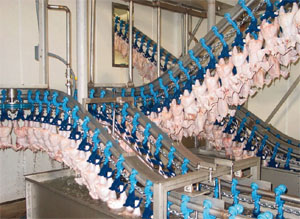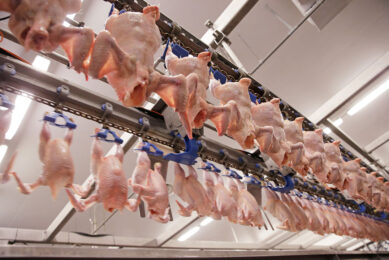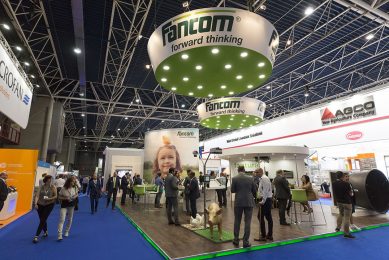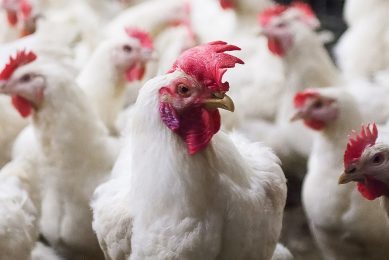Larger birds require high-speed cooling

Poultry companies in the fresh and processed poultry meat segment increasingly prefer larger birds. These companies frequently tend to forget that it takes more time and energy to lower the body temperature of these larger carcasses after evisceration than the traditionally-sized birds. TopKip of the Netherlands recognised the issue and created a solution that it believes gives processors many more rewards.
By Wiebe van der Sluis
While the market for high yielding birds is increasing, most processing companies are not able to process these bigger birds efficiently. The first steps in slaughtering are usually not a problem. At a given line speed most stunners, feather pluckers and evisceration machines can deal with a wide variety of bird weights. Problems occur when it comes to cooling, as most water or air chillers are designed to cool birds up to a certain weight. As soon as birds become heavier and the limits of these coolers have been passed, the carcasses will not be cooled enough, particularly not the inner breast and leg temperature as required by food safety inspection.
Several processors have experienced the issue and were faced with the challenge of expanding their cooling facility, which often means investments of over several million euros or dollars.
Saving time and money
“We have saved one company in the Netherlands millions through installing our combined air-water chiller,” says Wim van Stuyvenberg, CTO of TopKip. The company GPS in Nunspeet, the Netherlands, used to kill birds up to 2 kg, but when the birds it had to process went up to higher weights, the company struggled to achieve the right carcass temperature. Either inner temperatures were too high, or the outer temperatures were too low (frozen), or both. The only choice was to slow down the line speed, which consequently increased the cost of production. This was clearly not an option for the longer term, and it seemed that extending the cooling line was the only solution, however, this would require a several million euro investment.
A combi chiller can be installed in existing cool rooms while increasing cooling capacity dramatically.
After talking with TopKip about their combi in-line chiller, GPS gave it a try and installed a system in one of their two-lines. Soon after the first results became available, the company concluded that the system not only brought investment and energy savings, but also improvements in product quality. As a result, Martin Dirkse of GPS is a strong supporter of combi chilling. He says that from the start they believed in the principle of the combination of both water and air cooling. It took them a minimum amount of time to install the equipment in the existing facility, and also meant avoiding the timely process of getting the building and installation permits for an extended air cooling facility next to the plant. Following the success of the first installation, the second processing line was reconstructed.
Fast drop in temperature
Being the inventor of the system, Van Stuyvenberg recognised the advantages and disadvantages of both water and air cooling systems. He has seen many processors decreasing the cooling temperature and/or line speed in the chiller to quickly lower the carcass temperature. Many believe that a little bit of ice on the carcass will not cause any harm, and may speed up the cooling process. However, Van Stuyvenberg says that the opposite is true. He points out how fruit growers protect their fruit against frost during spring. By spraying fruit trees the frost creates an ice cover, which in turn protects the fruit from freezing.
This is not what you want to see in the chiller, though. He therefore made a 4-step process (Figure 1) by which carcasses leaving the evisceration line enter a rinsing tank, followed by a drip line to enter the pre-chilling tank containing water of 4°C (39°F). Thereafter they continue their way on a drip line, a third pre-chill tank, a drip line, and a fourth chill tank with water temperature below 2°C (<36°F). The carcasses continue to either an air chiller or an in-line water chiller to cool down to the desired temperature.
Figure 1 – The combi chiller alternately cools carcasses by air and water in order to drop the inner temperature fast.
No water uptake
The combination of water and air chilling proves to do an excellent job, says Dirkse. “It brings the carcass temperature down to the desired level in less than half an hour, whereas in the past took at least two hours. We gain the most during the first four minutes when the carcass is dragged through the combi chiller. The carcass temperature drops easily from 39 to 29°C or less, and after about half an hour in the air chiller we measure breast meat temperature of 7-9°C and an inner thigh temperature of 3°C. We reach this low level while the temperature in the air chiller does not go below zero, and thus never looses capacity resulting from frozen nozzles,” Dirkse explains.
This fast cooling result is normal and may differ a bit between companies due to the size of equipment and the length and speed of the chiller line, adds Van Stuyvenberg, pointing at data they collected from research trials (Figure 2).
Besides considerable savings in time and energy consumption, GPS sees major improvements in product characteristics. The end product is very clean and attractive, while there is no loss in yield and shelf-life. Cell counts, where it concerns Salmonella and Campylobacter, have remained at a very low level. When comparing today’s count lists we see improvements there as well, Dirkse states. “The only worry we had was the water uptake by the carcasses since the system alternately combines water and air chilling. EU regulations are very strict in this matter. However, the system has allowed us to remain within the limits. In fact, we did not see an increase in water up take at all.”
Accepted as being an air chiller
Traditionally, the poultry industry uses water chillers. They have been known for many years to be very efficient in cooling chicken carcasses, but they are also known for increasing water uptake, as well as possible contaminations. Since all carcasses end up in one big chiller tank, there is no way to put a 100% tracing and tracking system in place. These issues caused EU authorities to ban water chillers and only accept air chillers.
Confronted with the rules, Van Stuyvenberg is proud to reveal that, based on field experiences, the Dutch and European control bodies have certified the system as being an air cooling system, which in fact allows users to sell their products as being air chilled.
GPS is not the only company that experimented with the combi chiller. Marcel van den Heuvel of Flandrex, which since 2008 formed part of Plukon Royale, has probably the longest experience with TopKip’s combi in-line chillers. Their previous Goossens plant in Ommel, the Netherlands, was one of the first users. Here they installed the first working system in 2001, which was followed shortly after by two more. Today, the plant does not kill chickens anymore, but only processes poultry meat. Van den Heuvel convinced the new owners of the company that the combi-chiller had major advantages and caused them to remove the chillers and use them in one of the other slaughterhouses that Plukon owns.
The advantages seen by Van den Heuvel and Dirkse have not only lead to installing more systems in the processing plants that these two represent, but also to an increase in interest from companies all over the world, including the US, says TopKip’s CEO Ary Dirkzwager. “We have come a long way to convince people in the business, but we have sufficient proof that the system we developed meets the demands of most processors and authorities where it comes to efficiency, product quality and food safety.”













